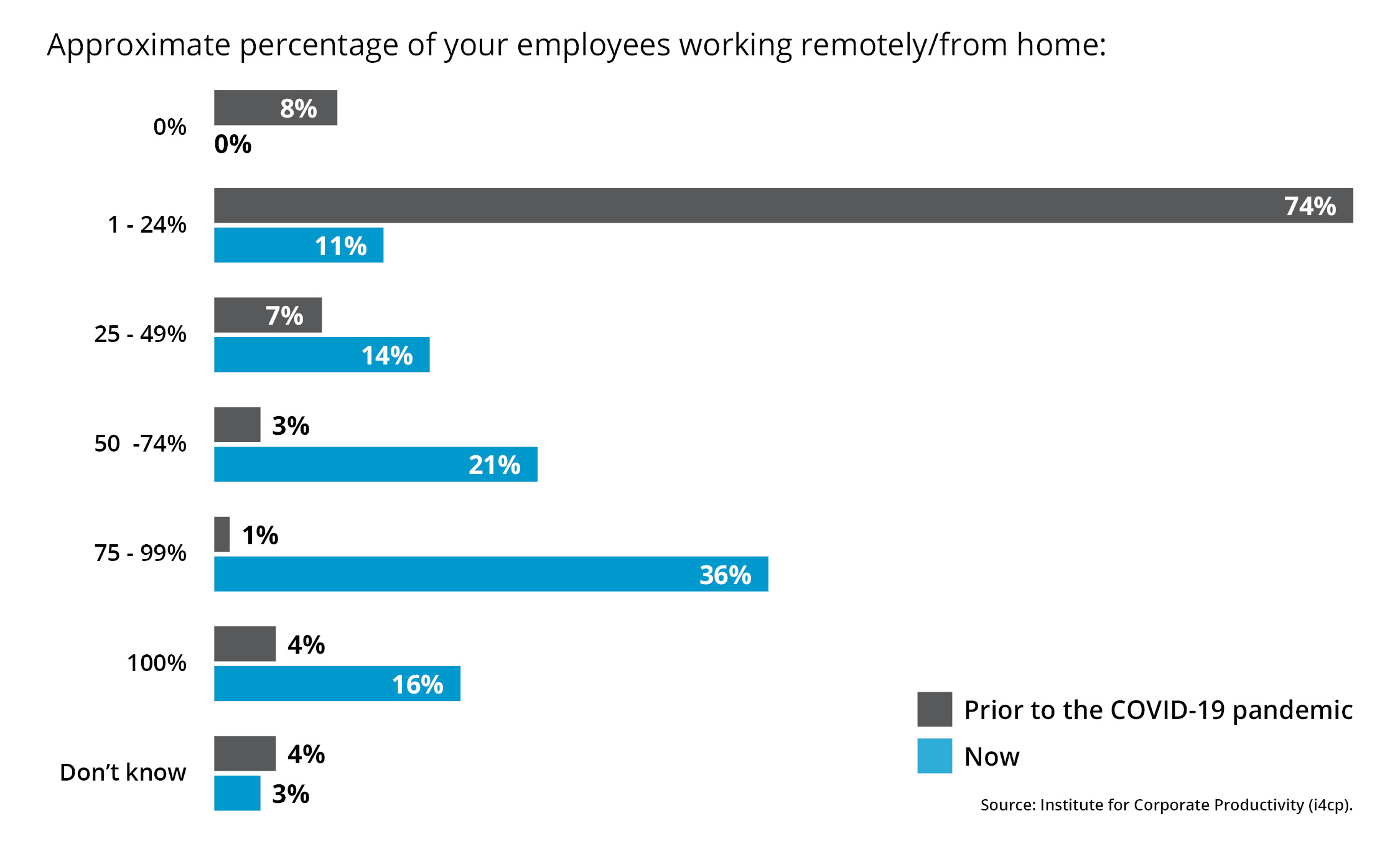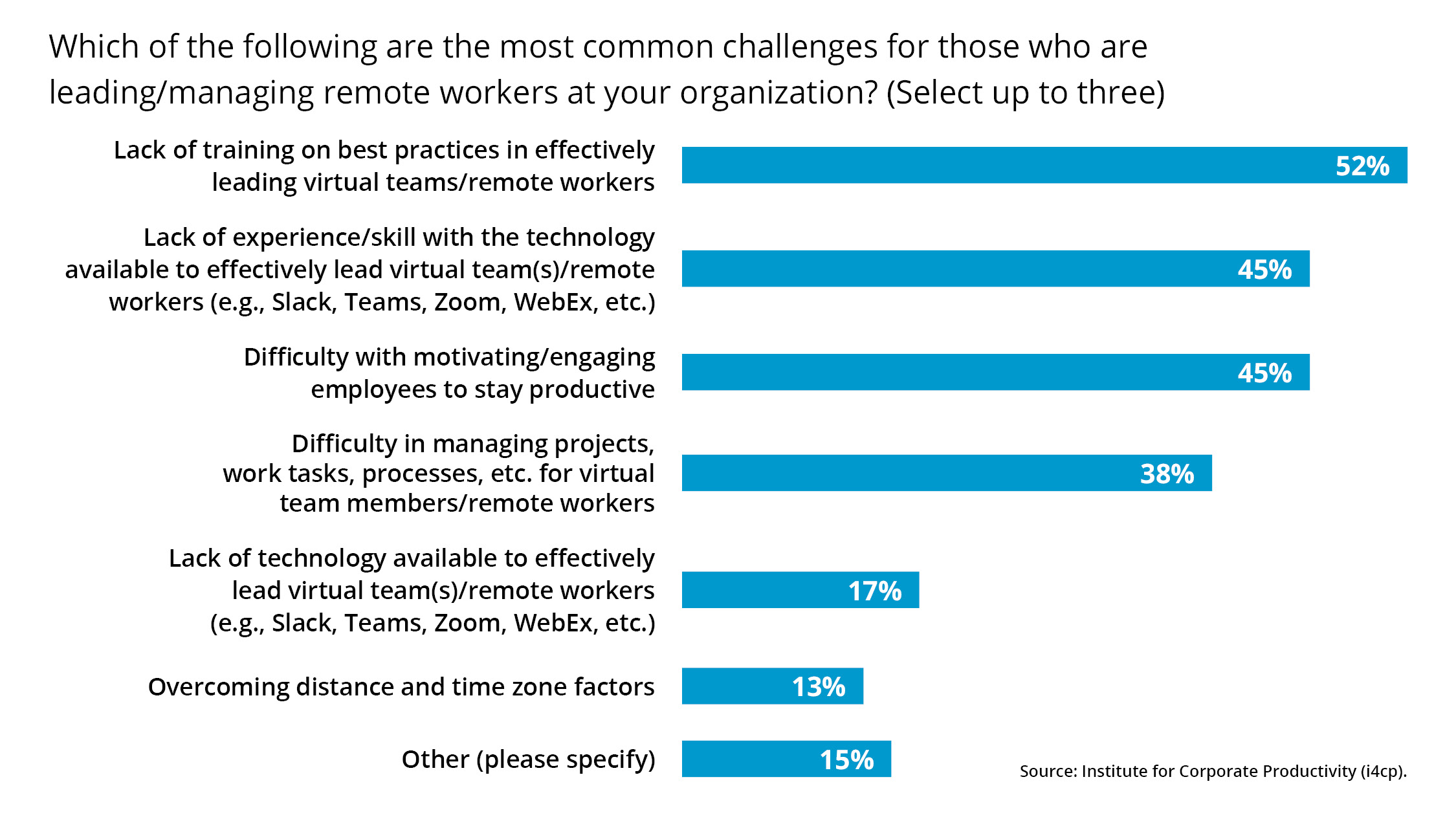The Massive and Rapid Shift to Remote Work and Virtual Leadership

The COVID-19 coronavirus has caused a slowly growing trend from the past decade to become a sudden, unchosen reality for millions. Not all jobs and tasks can make the shift to remote work—think retail workers, many manufacturing jobs, or engineers and scientists who work in big labs.
But for jobs that mostly require working via computers, phones, and similar common technologies, resistance to working from home was quickly swept aside in the past two weeks out of necessity.
Such were the findings of a new survey conducted by the Institute for Corporate Productivity (i4cp), which asked participants about the percentage of their organizations’ workforces that were already working remotely before the COVID-19 outbreak and what percent is doing so today.
The numbers are striking. Some degree of remote work was already common at most organizations prior to COVID-19—only 8% of respondents said they had zero such employees (a number that has now dropped to 0%, which is likely not literally true, but close).
The biggest shift was in the respondents whose organizations had a relatively low (between 1-24%) number of people working remotely prior to the outbreak. That group was 74% of respondents before COVID-19 and is only 11% now. Such organizations have increased the number of people working remotely to varying degrees, with the largest number of respondents (36%) now having a large majority of employees working remotely.
The percentage of respondents who indicated that over half of their employees currently work remotely has swelled from a meager 8% to a significant 73%. And amongst those, the number reporting that their organizations have gone completely to remote work has quadrupled from 4% to 16%.

Virtual Leadership
Given the interconnectedness of work today, organizations with more remote workers have more virtual teams, and with them more virtual leaders. While managing a virtual team is standard practice for some, for many this is completely new—and there are some challenges to doing it well.
How do you maintain productivity, engagement, and morale of employees who are struggling with this new way of working? What about those who are more experienced but suddenly need to collaborate with those who are new to it?
Our survey found that a lack of technology (e.g., Slack, Teams, Zoom, WebEx, etc.) is not the major challenge, with only 17% of survey respondents saying it was a top-three concern. Rather, a lack of experience with those technologies on the part of leaders is a significant challenge (45%), topped only by a lack of training on best practices in effectively leading virtual teams/remote workers.
The lack of training was foreshadowed by research i4cp conducted on virtual leadership prior to COVID-19. In that study, only 29% of survey respondents indicated they thought leaders in their organization were effective at leading virtual teams / remote workers.
Training designed and delivered specifically for virtual leaders was found to be a next practice, not commonly done but used by 4.5X times more high-performance organizations than lower-performers. The top skills needed more often by virtual leaders than traditional leaders? Digital fluency, facilitating collaboration, cultural agility, and helping others build strong networks topped the list of skills we surveyed. (See the i4cp infographic: 7 Critical Skills for your Virtual Leader Training.)
Our virtual leadership research discovered additional best and next practices beyond providing focused training for virtual leaders. One is not appropriate right now: hosting one or more in-person events for remote workers to get together for team building, collaboration, etc. Definitely a great idea, just not during this COVID-19 time period.
But the other top practices can and should be pursued by virtual leaders, including holding non-business virtual meetings (celebrations, virtual coffee/happy hours, etc.), modelling the best use of communication software, and setting virtual team operating agreements (i.e., a set of behavioral norms that the virtual team agrees to abide by).
The peak of the COVID-19 pandemic will come and go, and only time will tell how much of the surge of remote work and the need for virtual teams and virtual leaders will continue. It is a safe bet that at least some of the increase will live on, so it is time well-spent now to focus on virtual leadership best and next practices.





